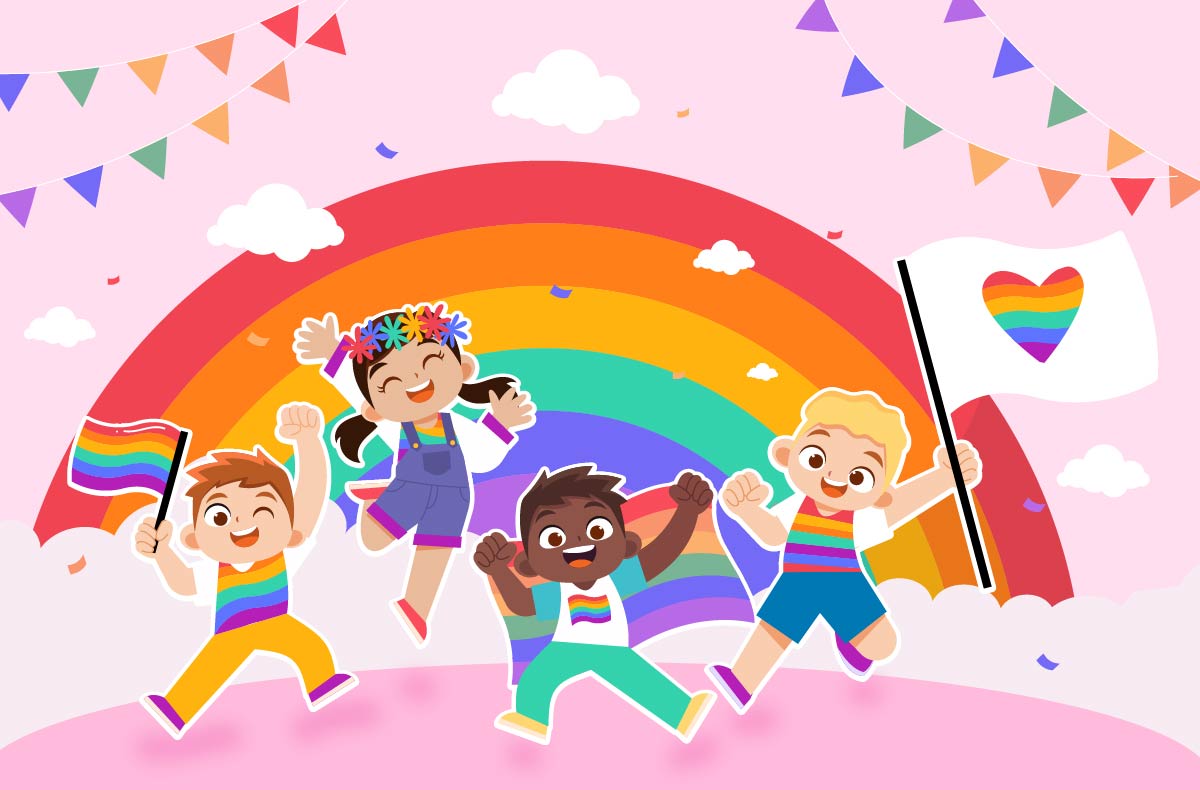
Illustration by Sarameeya Aree
For those readers who oppose teaching CRT in schools, brace yourselves. I believe we need to teach some variation of a Critical Sexuality Theory (CST?) as well. I’m so committed to the idea of teaching my 4-year-old about gay pride, that I pushed my kid’s preschool to have a Pride Parade.
In a scene from the Westboro Baptist Church’s worst nightmare, one of my favorite pride memories is watching 60 kids aged 6 months to 5 years old walking around in rainbow attire waving colorful flags. Hear me out—you might push your preschool to celebrate Pride too.
Two years ago, I had a two-year-old preschooler who was lucky enough to have celebrated Diwali and Lunar New Year, learned how to write his name in Japanese characters during AAPI History Month, and recounted the story of Rosa Parks after a lesson during Black History Month. I was happy to have chosen a children’s center that used culturally-responsive teaching approaches in early-childhood education. I bragged about the education my little learner was receiving and awaited newsletters that reported what he would learn the next month.
When June rolled around, Pride wasn’t mentioned. While I’m happy that my child was introduced to phonics and got extra waterplay, I kept waiting for some mention of LGBTQ history. Alas, no rainbow art showed up in the weekly crafts being sent home. Halfway through the month, I decided it was time to push for instruction that was LGBTQ+ inclusive.
I went back and forth about whether or not to stir the pot. I thought, “Do they think it would be offensive?” or “Are there some parents that would be against this?” But I quickly challenged such questions by reminding myself of three major reasons for pushing for pride: (1) We must continue the project of destigmatization; (2) It’s ok for people to sit in discomfort; and (3) my silence would be complicity.
Being gay or transgender is stigmatized across the country. Seemingly every day, another state bill is signed that does not protect children from bigotry and hate. The result is severe depression in LGBTQ youth. The even harsher reality is the rate of suicide for queer and trans kids. In order to destigmatize being gay, queer, trans, or nonbinary, we must start conversations about sexuality, gender, and variations in family structure early on. States such as California require schools to teach about LGBTQ history. Starting these conversations even earlier can help to socially construct a reality that values difference and supports LGTBQ folks in policy and in practice.
I don’t mind that some people might feel uncomfortable about instruction that highlights LGBTQ history. People might claim that they aren’t homophobic, but “just don’t want to see such a public display.” Yet, we see a public display of heterosexuality on a daily basis: in the media, in restaurants, and in political office.
Pride month is an opportunity to highlight what typically remains hidden or rarely discussed. And the discomfort that one might feel at the thought of broaching such topics with a preschooler should give them pause to ask why they feel the way they do toward LGBTQ folks and relationships, while not questioning the public display or conversations about heteronormative relationships, love, and families.
Discomfort helps us to grow. It helps us to move in new directions. Sometimes we need to feel uncomfortable in order to challenge our viewpoints, take in new information, and build informed belief systems.
When I was waffling over whether or not to contact my kid’s preschool, I ultimately came to a point where I didn’t care if I offended somebody by questioning the lack of instruction related to LGBTQ history. To be clear, I am a white cis-gendered woman in a heteronormative relationship with a white cis-gendered man.
It is my responsibility to speak up for my queer friends and family, celebrate their love, and push for equity. This was one small way to do that. Had I not decided to raise the issue, I would remain complicit in a society that treats some of its citizens as less than, abnormal, and outcast. It is everyone’s responsibility to change this.
So, I emailed: “I wanted to reach out and say that I really appreciated the commitment to a diverse curriculum for Black History month and Asian-American Heritage month. I noticed that the kids were learning about someone new/notable each day and that activities were tied to these lessons.
I haven’t seen anything being done for Pride month and I’m wondering if there is a reason for this. I’d love to see [my kid] learning about Harvey Milk and other notable LGBTQ folks.” I received a thank you, an admittance that more could have been done, and a few days later, an invitation to the center’s first annual Pride Parade!
A Pride Parade is where things started. The next year, students read a book about American artist Keith Haring and his AIDS activism, the 3-year-olds were prompted to lay on large rolls of paper in any shape and trace their bodies to emulate Haring’s artwork. Children painted pride flags to carry at the parade and learned about the significance behind the rainbow. Instructors read about famous activists like Harvey Milk and talked about different family structures. And families could choose to continue these conversations at home. This year, the center will hold its third annual Pride Parade and a new generation of students will learn about LGBTQ History.
I’m glad I pushed the center to celebrate pride. It means that generations of kids will have the language to talk about sexuality, gender, and inclusiveness. And, it means that the next person won’t have to ask. But there are plenty of childcare centers that still need that push.
Maybe you’re the next person to make it happen.


